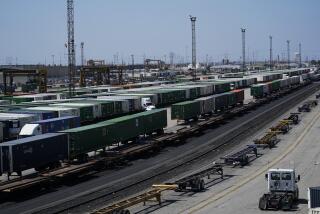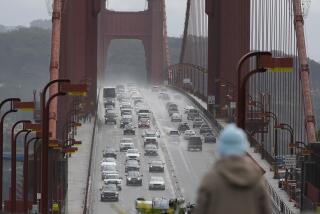New Rail Law May Silence Dinah’s Horn
- Share via
WASHINGTON — The train of legend chugged through picturesque countryside by day and by night, its whistle announcing its approach with an eerie, romantic sound. But in a more urbanized America experiencing a surge in rail traffic, the romance has mostly disappeared, and the government is being called on to extend its regulation of the once lonely whistle.
Places that have other safety measures in effect -- for example, barriers to stop motorists from zigzagging around lowered gates -- will be allowed to ban the sounding of train whistles at railroad crossings.
The new federal rule announced Wednesday will be welcomed by officials in cities whose residents value a good night’s sleep more than a sound reminding them of a bygone America. But it will probably cause a commotion in cities unable to afford the safety improvements at railroad crossings that will be required.
“Train horns are important safety devices, but they also can be a nuisance for residents,” said Transportation Secretary Norman Y. Mineta. “This rule means less noise for millions of Americans living near railroad crossings.”
In Orange County, the cities of Placentia and Anaheim are already moving to put in place nearly $7 million in safety upgrades at eight railroad crossings in an effort to silence horns from 70 trains a day.
“It costs a lot,” said Chris Becker, executive director of OnTrac, the joint powers authority in charge of the project. “Communities across the country are going to find that’s going to be the main drawback.”
The new Federal Railroad Administration rule, which will take effect in a year, applies to about 150,000 public railroad crossings nationwide.
In 1994, Congress required the railroad agency to issue a regulation on the use of locomotive horns at railway crossings. It gave regulators the authority to write a rule that would establish “quiet zones” where there was no significant safety risk or where safety devices could compensate for the absence of the whistle’s warning.
Under the new rule, communities can ban train whistles if there is a low risk of collision or if they implement safety measures, such as installing crossing gates that block traffic in both directions, or install cameras that photograph people pulling around gates so that they can be given traffic tickets. The rule also allows use of an automated horn system installed at the crossing as a substitute for the train horn.
The issue has attracted the attention of political heavyweights such as House Speaker J. Dennis Hastert, a Republican, and other Illinois lawmakers who have complained that the horns not only strain residents’ ears but also decrease property values.
The new rule, federal officials say, seeks to strike a balance between safety and quality of life, a clash that has grown in urban areas undergoing a boom in rail traffic. In the Los Angeles region, Metrolink commuter train service has grown from three routes encompassing 112 miles of track in 1992 to seven lines traveling 512 miles of track today.
Despite the increase in rail traffic, motorist deaths at railroad crossings declined to 357 nationwide last year, down from 421 the year before, according to the railroad administration. In California, 30 motorists were killed at crossings last year, down from 54 the previous year. Those figures do not include the 51 deaths, excluding suicides, along the Los Angeles-to-Long Beach Blue Line since the rail line began operating in 1990.
Federal officials said the new rule will reduce the noise from train horns for more than a third of the 9.3 million people nationwide affected by the sound. The rule also requires that horns be sounded 15 to 20 seconds before arrival at a crossing, rather than from a quarter-mile away, and establishes a maximum 110 decibels, down from the commonly found 114 decibels.
Locomotive engineers retain the right to blast the horn in an emergency, even in a quiet zone.
In California, Richard Clark, director of consumer protection and safety for the state’s Public Utilities Commission, said the agency looked forward to working with federal regulators, “as they have given us much-needed flexibility to deal with situations on a case-by-case basis to determine whether we can diminish noise without compromising safety.”
The Assn. of American Railroads’ president and chief executive, Edward R. Hamberger, praised federal regulators for writing a rule that “recognizes public-safety concerns and allows localities to develop alternatives to reduce train-horn noise in residential neighborhoods.”
Communities with existing whistle bans will have at least five years to implement its requirements.
More to Read
Sign up for Essential California
The most important California stories and recommendations in your inbox every morning.
You may occasionally receive promotional content from the Los Angeles Times.














